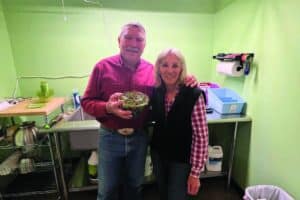By Erin Malcolm
There are 4,000 species of bees native to the United States; and, of those, nearly 1,000 are native to Colorado, according to the United States Geological Survey and Colorado State University.
Given that Colorado boasts the fifth most diverse bee population in the country (according to the University of Colorado Boulder Museum of Natural History), it is vital to care for and protect Colorado’s bees — especially now, in the face of a worldwide bee population decline.
Considering the multitude of services that these pollinators provide for the planet and for people, the issue could be detrimental to society if it is not remedied.
“There are a lot of services that (pollinators) provide that we’d be sunk without,” said Joyce Kennedy, the executive director of People and Pollinators Action Network. “Our pollinators are key to ecosystem management. They are responsible for over 80% of pollinating our plants. And even some really simple things, like pollinating what gives us shade.” For Colorado specifically — a state that so heavily relies on agriculture and tourism for economic success — even things like raising cattle that eat plants that rely on pollination, or farming pollinated crops or visiting a mountain meadow filled with wildflowers are all dependent on the hard work offered by pollinators like bees.
One of the most threatening contributors to the decline of bees is habitat loss, Kennedy said.
“As we put in more roads, pavement and parking lots, we lose native vegetation. And in agricultural areas that have monocropping, where we have acres and acres of single-crop farms where we’re only raising corn or soybeans, that again has taken away this diverse banquet for bees,” Kennedy said. “If we’re not feeding our bees, they’re not going to be healthy, and they’re not going to be able to do their important job.”
Pesticide misuse also plays a role in harming the bee population.
Pesticide Program manager at the Colorado Department of Agriculture, John Scott, said, “Pesticides not used according to label directions can negatively affect pollinators. Not all pesticides cause negative impacts on bees, but those that could will have pollinator protection language on the protect label that must be followed. The label is the law.”
Currently, persons who get caught misusing pesticides can be fined up to $1,000 per violation. Effective Sept. 1, 2023, the fine will increase to $2,500 per violation in accordance with the recently signed Senate Bill 23-192.
Mike Halby, long-time beekeeper and president of the Pikes Peak Beekeeper Association, noted the importance of balance while protecting bees and still acknowledging that pesticide use can be necessary for agricultural purposes.
“Pesticides have their value when you look at commercial growing operations. There’s going to be some use there,” Halby said. “But, the more that are developed that are less lethal or non-lethal (to bees) is a benefit to both communities.”
While Kennedy described pesticide use as “astounding” and “detrimental,” she also agreed that the agriculture industry is not solely to blame for the pesticide-related problems bees face. “Let’s not forget about the use of pesticides in our parks and residential areas. ‘Joe homeowner’ tends to overuse and not read pesticide labels, so we’re not just pointing our fingers at farmers who are going to be the ones to use pesticides by the label,” Kennedy said.
A bill that passed this year, called SB 23-266 aims to limit access to bee-harming neonicotinoid pesticides by only allowing licensed dealers to sell them, which removes them from retail store shelves.
In addition to supporting legislation such as that mentioned above, the Pollinators and Pesticides network has also worked to designate I-76 as Colorado’s first pollinator highway. They also want to pass pollinator resolutions in communities to help people talk to local leaders about ways to help bees. Plus their efforts include getting a bill passed to introduce a donation-based pollinator license plate in which donations funnel through the network to a pollinator habitat fund that helps establish new spaces where pollinators can thrive.
But there is still much more to do and learn about this issue.
Kennedy said, “We know overall from studies done in the U.S. and globally that we’re losing these insects at an alarming rate.” But when it comes to the overall losses in Colorado, she said, “We can’t say very specifically how many numbers we’re losing here. We don’t have a broad statistical analysis of such things.”
So far, one state-specific fact that is known, according to a report by the Proceedings of the National Academy of Sciences, is that the western bumble bee species has declined by 72% in the southern Rocky Mountain region over the past two decades.
To prioritize learning more, PPAN worked alongside local pollinator champions at the state Legislature last year to initiate a study called the Native Pollinating Insects Study through the Department of Natural Resources, which will identify the gaps in current state information. “This study is taking place this year, will be done at the end of 2023, and will really give us more of a state-condition of pollinators here,” Kennedy said. “I think it will give us some important next steps.”
In the meantime, the next steps start with everyday people in their own backyards.
“The best thing that people can do is research some bee-friendly plants in their area and plant some of that to give the bees a source of food,” Halby said.
Kennedy has noticed this becoming a trend that folks call “Colorado-scaping.” She said, “It connects back to what Colorado is supposed to look like. We’re in an arid climate, and we should be relying on our native species that are going to feed the pollinators. The idea that we should be having green, lush lawns is something we’re working to change. We need to get people thinking differently about how we see our landscapes.”
Kennedy has seen this simple first step of planting native bee-friendly species in yards escalate in a positive way, she said.
“Some people will do just that step — plant some flowers and be done with it. But somebody else will then become a pollinator-safe community leader, talk to neighbors, host a plant swap talk to town leaders,” she said. “Everybody can do something. I think that’s what’s really empowering about this issue.”






